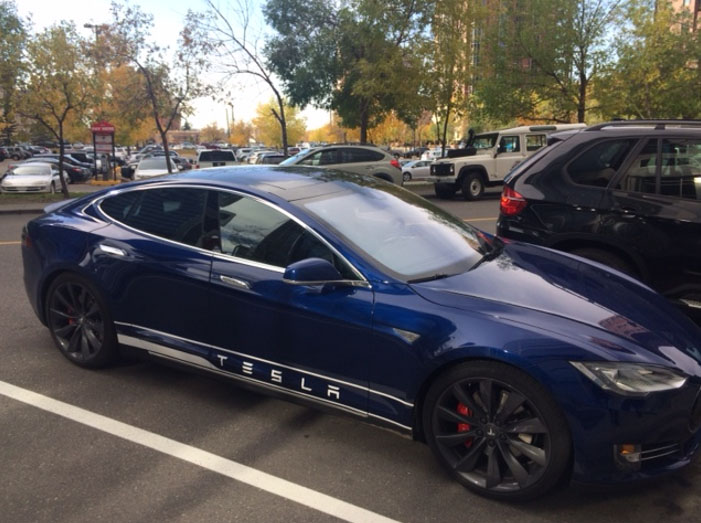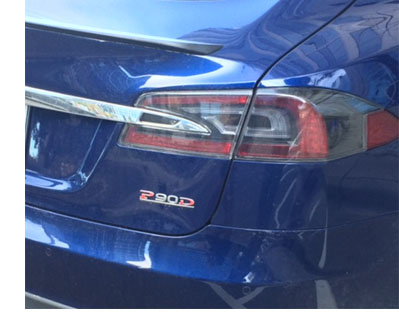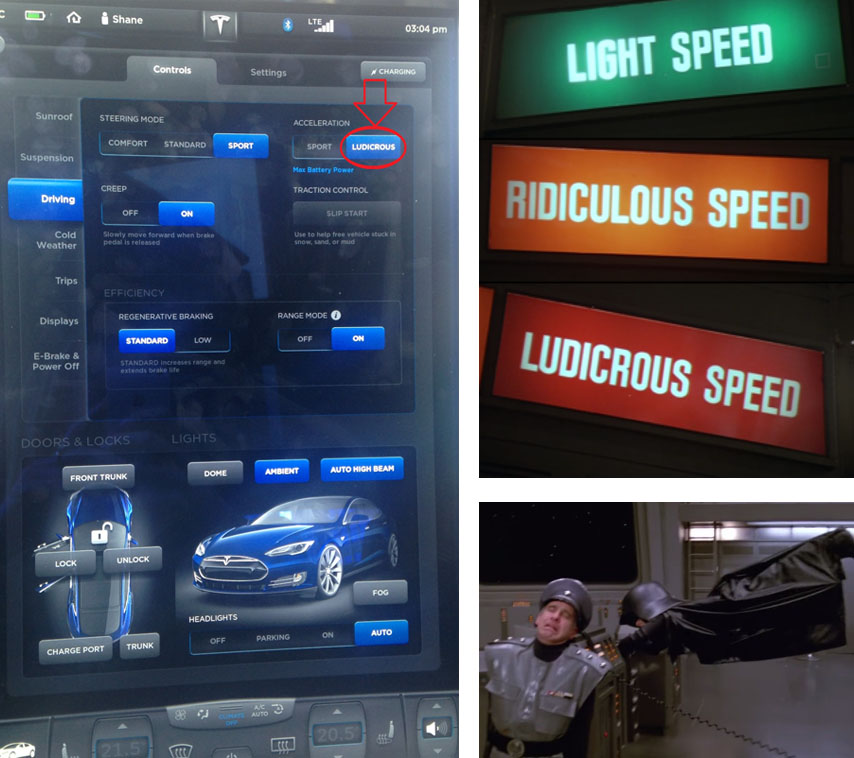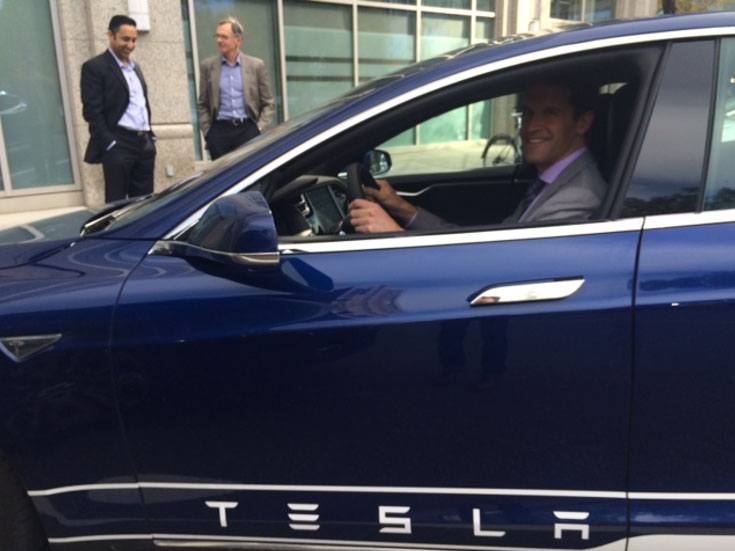I hadn’t intended to add a fourth segment to my series on electric cars, or intended to turn this into a forum for automotive journalism, but an opportunity to personally test drive the latest offering from Tesla presented itself last week, and I feel that it was definitely worth writing about. It wasn’t just any Tesla that I got a chance to get behind the wheel of, it was the top-end ‘P90D’ version of their Model S sedan that had been loaded with basically every option available. This model, as tested with every conceivable option, costs about $USD 125,000 (or $CAD 170,000 in our much depreciated Canadian dollars) and has the impressive performance stats of being able to accelerate from 0-60mph/(or 0-100km/h) in about 2.8 seconds and has the ability to cover a straight line ¼ mile (0.4 km) from a standing start in 10.9 seconds. While these numbers may be lost on non-car enthusiasts, I’ll try to put it in perspective. Basically, there are only a handful of other production cars on the planet currently that can match or beat this acceleration and most of them cost hundreds of thousands, if not millions of dollars more and come from exclusive brands like Ferrari, Lamborghini or McLaren. The cars that can actually beat a Tesla P90D are generally specialized track tuned performance cars that also lack things like a back seat, a trunk that can fit more than a bag of groceries and often leave out other features like air conditioning and stereo systems to save weight. Basically, most of the things that would actually be useful in everyday driving or carting a family around town don’t apply. The Tesla, by contrast is a large four door family sedan with a comfortable back seat, a massive trunk and has every technology and comfort option available that you could ever want in a car. It is completely functional for every day driving.

 I’ll try not to bore everyone out there who sees a car as simply an appliance to get you from A to B, like a dishwasher is for cleaning your dishes (if you fall into this category feel free to stop reading any time). At well over $100,000, this particular version of the Tesla Model S isn’t an inexpensive car by any measure. That said, it is far more within reach than, for example, the latest top end Ferrari ‘LaFerrari’ at around $USD 1.5 million, that posts slightly faster, but not dissimilar acceleration numbers. The base model version of the Tesla starts at $USD 70,000 or roughly $CAD 85,000, and is slightly slower, but still impressive when compared to other cars in that price range.
I’ll try not to bore everyone out there who sees a car as simply an appliance to get you from A to B, like a dishwasher is for cleaning your dishes (if you fall into this category feel free to stop reading any time). At well over $100,000, this particular version of the Tesla Model S isn’t an inexpensive car by any measure. That said, it is far more within reach than, for example, the latest top end Ferrari ‘LaFerrari’ at around $USD 1.5 million, that posts slightly faster, but not dissimilar acceleration numbers. The base model version of the Tesla starts at $USD 70,000 or roughly $CAD 85,000, and is slightly slower, but still impressive when compared to other cars in that price range.
Chris Bishop is the first Tesla employee in Alberta and has recently relocated to Calgary from Vancouver, where he says that electric adoption rates are increasing much faster than anyone appreciates (Feel free to visit the Chinook Centre display, where he and his colleagues are happy to show anyone the Model S.) According to Chris, despite being in Calgary for less than a month the demand for the car has been overwhelming. It is interesting that electric cars would gain the popularity they have in a city that is faced with industry-crippling low energy prices and massive layoffs from major energy companies. Chris stated that the Tesla Model S sales in Canada have already grown 150% year over year and it’s only September.
Chris took a few minutes to describe the features of the car, and had us sign a waiver promising that we would drive responsibly and obey all posted traffic laws, which might be the only downside to the car – the temptation to do otherwise. After this, we were off. The most noticeable thing about the car (or not noticeable thing, depending on how you look at it) is how quiet it is. Despite having two electric motors that combine to produce over 750 hp, you barely hear any engine noise, except for the quiet whine and somewhat science-fiction like sound of an electric motor somewhere in the floor beneath you.
Cars obviously need to do more than just accelerate quickly, and I’ll get to the other features later on, but the performance of this model really stands out. When you set out in the P90D and step on the gas pedal (sorry, no gas in this car) accelerator pedal, it is hard not to be taken aback by the sheer power that is available. There are no gears to shift and because of the nature of the torque that is produced by the electric motors, the car is at full acceleration from a standstill with no need to rev up the engine in advance. In order to attain maximum acceleration you have to pre-set the car to an acceleration setting called ‘Ludicrous’. I find it quite humorous that you can actually buy a high-end luxury car with a setting called ‘Ludicrous’. For those of you who don’t remember the pop culture film from the 1980s, ‘Ludicrous mode’ is a nod to the 1987 Mel Brooks parody of ‘Star Wars’ called ‘Spaceballs’. There is a scene where the Darth Vader parody character called ‘Dark Helmet’ (played by Rick Moranis) tells his officer, Colonel Sanders, that taking their spaceship to light speed is too slow, and they have to take it all the way to ‘ludicrous speed’. (To save you from having to re-watch the whole film, the specific clip is available on YouTube if you click this link). The car clearly had some engineering nerds from Silicon Valley working on the programming. In the movie, the characters are basically pinned to the backs of their seats from the acceleration when the ship accelerates from ‘light speed’ then to ‘ridiculous speed’, and then all the way to ‘ludicrous speed’. This actually isn’t too far off from what it feels like when you step down to full acceleration in the Tesla.

As a bit of research and background for this blog I stopped by a local newsstand and purchased copies of the three popular car magazines that were available: ‘Car and Driver’, ‘Motor Trend’ and ‘Road and Track’. The cover story on Road and Track featured the latest tuned up Ford Mustang, the Shelby ‘Super Snake’ edition that brags of producing over 750hp. This version of the Mustang does look like a fun car to drive, if you like melting your rear tires and making a lot of noise. The 10 page spread on the Shelby Mustang ‘Super Snake’ complete with numerous colour photos, track tests and performance numbers was an interesting read. However, after driving the Tesla, it felt like reading an article on one of the world’s best kerosene lamps after having just tested out the electric light bulb straight from Edison’s lab. The world is changing and it is happening more quickly than we may realize. Recall that in the not too distant past, the regrettable practice of burning whale oil in lamps for lighting was commonplace, before kerosene was derived from crude oil. Fortunately we have since switched to much safer, cleaner and more efficient ways to light our homes and buildings.
Looking at the performance numbers of the Mustang Super Snake, this approximately $USD 100,000 gasoline powered sports car tested acceleration numbers of 0-60 mph in 3.9 seconds and covered a ¼ mile in 12.3 seconds. The Ford’s numbers are impressive for nearly any conventional car, but they are more than a full second slower than the Tesla in both measures. It is interesting to note that in all three of the automotive magazine’s current issues, there is no mention whatsoever of the Tesla. It is not included in Car and Driver’s annual ‘Lightning lap’ shoot out that boasts a test of 18 of “This year’s hottest performance machines”. Pricier cars from Porsche, Mclaren, Mercedes and Lamborghini were included in the comparison feature, as well as other cars at a similar price point to the Tesla, so cost obviously wasn’t an issue. I don’t know if Tesla has declined to provide these magazines with test cars, or the magazines are simply in denial that the game has changed and don’t feel that it is a fair comparison to put an electric car in a comparison test with the latest gasoline powered sports cars. To be fair, Car and Driver did have a four page article on the latest Chevrolet Volt, an electric plug-in hybrid that is designed more for efficiency than performance. Perhaps the world of automotive journalism is reluctantly acknowledging the existence of these new types of cars.
There are a number of other things that become clear when you drive a Tesla. They actually become clearer when you go back to driving an internal combustion car. Driving home in my six year old Honda truck that day felt as though I was driving a tugboat. It felt big, slow, noisy, and difficult to turn. I feel kind of bad even saying this, as my Honda has served me very well since I have owned it, and it has provided me with over six years of flawless reliability. Although by comparison, the amount of technology that is packed into the Tesla is impressive and it feels like suddenly being introduced to the latest iPhone, when before you were using an old cellular flip phone. While both an old flip phone and an iPhone can make phone calls, just as both my Honda and the Tesla can transport me from one place to another, the Tesla can do whole lot more along the way. The main console features a bright 17” touchscreen that the driver can use to browse the internet, navigate traffic, and find the nearest restaurant or charging station. The touchscreen is also used to control ride height, temperature control, open the sunroof and basically adjust everything in the car you can think of adjusting.
The Tesla also has an autopilot mode that works off of 12 sonar and radar sensors that allow a driver to move through traffic without having to steer. The driver can instruct the car to change lanes by itself by simply flicking the turn signal. The car also has a ‘creep’ function that allows the car to creep along in stop-and-go traffic without any input from the driver. In theory, this could free up the driver to read a book, eat lunch or do other things behind the wheel that would otherwise be forbidden in traffic, while leaving the car in control. The car can also detect a parking spot on the street and park itself or allow the driver to step out of the vehicle while the car parks itself in the garage at home. Tesla is clearly well down the path of creating a fully autonomous car and it is their prediction that the technology will be available and in production in the next five years.
The other interesting thing to note is that the car can actually get better as time goes on. Tesla engineers are continuously working on updates to make the car more reliable, more efficient and are even adding new features. Similar to how a smartphone will update the operating system software or the apps will continuously update with newer versions, features and fewer bugs, the Tesla will do the same with its onboard software and control systems. The Tesla could potentially even be loaded with updated software that could make it quicker or handle better. That’s right, I’m sure that as you read this, somewhere a Tesla engineer is working on optimizing the power management systems and engine torque curves to squeeze out even quicker acceleration, or tweaking the software that controls the traction control systems to improve vehicle handling in tight corners.
We asked Chris how a Tesla would handle a Calgary winter or snowy conditions and he said that it would perform very well. The car has a highly sophisticated four wheel drive system and sensors that take over 1000 readings per wheel per second, and actively compensate for any wheel slip or skids. We tested the Tesla on a clear sunny day and only had dry roads available, but the little bit of tight cornering that we were able to do did demonstrate some impressive road holding and handling abilities. Chris claims that, with all of the control systems onboard the car, it is nearly impossible to put the Tesla into any kind of skid or slide on purpose. Recalling the waiver that we had signed and the fact that we were in traffic on city streets, the opportunity to really push the car to its limits and test this claim was somewhat hindered.
When asked about how the Tesla’s batteries would handle cold weather he did say that they do use some of their power to keep the system warm. I would guess that if you need to leave it out on a cold night you would want to find a place to plug it in. Fortunately, in the colder parts of Canada it isn’t too difficult to find a block heater outlet. Apparently, Norway is one of the top markets for Tesla cars as the government incentives for electric cars are very enticing there. The entire country of Norway is further north than most populous Canadian cities and has winters that are equally cold and snowy. The Norwegian capital of Oslo is at 59 degrees latitude north, and Edmonton is at a balmy latitude of 53 degrees north by comparison. Even with purchase incentives, it is doubtful that the Norwegians would buy cars that would risk leaving them stranded in the cold.
Is the Tesla just another car that happens to run on electricity, or is it a catalyst for change in the automotive world? It was a busy news week last week and as I woke up on Monday morning I read a headline that Volkswagen, which had just recently become the world’s largest automaker, had been busted by the US EPA for designing a cheat into their exhaust control systems on their diesel cars that basically turned off the pollution controls unless the car is plugged into an emissions testing system. While their diesel pollution control systems do work fine when the system is turned on, actually turning it on has the negative effect of reducing the engine’s power and the car’s overall fuel economy. It is a shame that rather than designing a better pollution control system, or a better car to meet the regulatory requirements, a group within Volkswagen designed a software system that simply cheated the test. It was remarkable that is came from Volkswagen, what was a reputable global company that had built their name on fuel efficiency and quality cars. The news of this Volkswagen cheat felt like learning that a previously squeaky clean sports hero had been caught doping.
While the long term fall-out from the Volkswagen investigation remains to be seen, it has the potential to more quickly usher in a new era of automotive technology. Tesla started from scratch about a decade ago and has been selling their model S since June 2012. It does seem like a daunting feat for anyone to build a start-up company that will take on some of the biggest and most established companies in the world in any industry, and the automotive industry seems particularly challenging due to the high barriers to entry and the immense amounts of capital required. Tesla has created everything from sales networks and a comprehensive network of electric charging stations, to R&D and manufacturing from nothing more than an idea about a decade ago, while others have been at the automotive manufacturing game for about the past 100 years. Furthermore they are riding a wave of wealthy and influential green, early adopters. It also offers buyers a very ‘green’ status car that looks great and is truly amazing to drive.
Will Volkswagen cling to their diesel technology after their recent pollution control scandal? Or is it simply too difficult to meet the ever more stringent emission standards with combustion technology? In light of the Volkswagen scandal, the chief of staff to the German Chancellor challenged all of the German automakers to “beat Tesla” and produce better and more affordable electric cars. After driving a Tesla, it does make you realize that if a small start-up from California can put one of the quietest, most efficient and best performing cars ever created into production in less than a decade, other much larger and well-established car makers don’t have any excuses not to compete.

The opinions expressed in this report are the opinions of the author and readers should not assume they reflect the opinions or recommendations of Richardson GMP Limited or its affiliates. Assumptions, opinions and estimates constitute the author's judgment as of the date of this material and are subject to change without notice. We do not warrant the completeness or accuracy of this material, and it should not be relied upon as such. Before acting on any recommendation, you should consider whether it is suitable for your particular circumstances and, if necessary, seek professional advice. Richardson GMP Limited is a member of Canadian Investor Protection Fund. Richardson is a trade-mark of James Richardson & Sons, Limited. GMP is a registered trade-mark of GMP Securities L.P. Both used under license by Richardson GMP Limited.